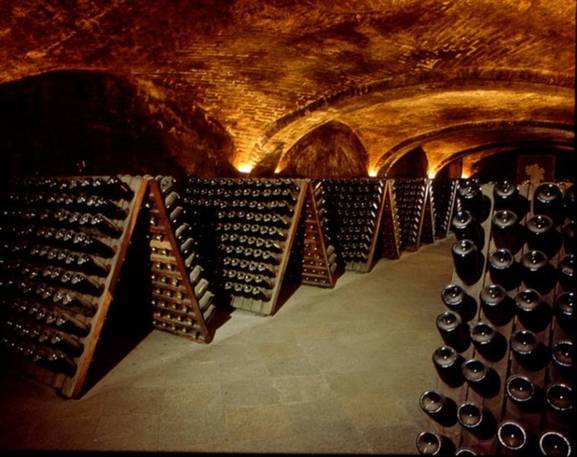


Italy is a land of many realities, each region, city, town, municipality and home has a story to tell, something almost magical that makes it unique and cherished. As we are getting ready to toast to the holiday season, Italian wines are flying off the shelves. In this context we want to tell the unique story linked to some of Italy’s most known wines… the wines of Asti [2].
It all starts in Canelli [3], an idyllic municipality in Piedmont, dominated by a castle surrounded by a medieval hamlet. The area around the town is rich in vineyards and is believed to be the birth place of the Italian sparkling wine Asti. The village's history of the wine is still evident today with the popular synonym of “Muscat Canelli” that is still used for the Moscato grape used to produce the wine.
The town’s most unique characteristic is the peculiarity of its subterranean wine cellars. We are talking about an extended architectonic fortune of “Underground Cathedrals” that wiggle below the entire city for about 20 kilometers (12 miles), and disappear on different levels in the viscera of tufa hills (all the way to 32 meters/104 feet underground) thus creating really suggestive scenarios: real masterpieces of engineering and architecture. In the naves of these cellars, bottles of prestigious wines are aged at a constant temperature of 12-14 ºC (53-57 ºF) degrees.
In the mid 1800’s, Piedmont’s production of white Muscat grapes was centered in the Canelli area, while another came from the nearby municipality of S. Stefano Belbo and the rest from the neighboring municipalities. A big chunk of the wine was commercialized in barrels that the barrooms and taverns of the area resold by the flask or by the glass. “Vermouth” had Muscat as its base wine and in order to turn it into sparkling, alcoholic fermentation had to happen in the bottle. This radically changed production: companies evolved from artisanal production to a more “industrial” method. Vermouth and “Muscat Champagne” (“Muscat Canelli” as it was called at the time) rose to popularity at the same time, so much that, in order to meet requests, dozens of production houses were opened in the historic center. After the construction of the railroad they were distributed in the Muscat production area, thus starting a phenomenon that involved the entire local production.
The processing of the Spumante (sparkling wine) needed, and still needs today, a constant temperature of 12 – 14 ºC (53-57 ºF) all year long, so wine producers needed the right cellars that, in order to guarantee that temperature, necessarily had to be underground. The hilly layout of the area and the earth’s composition had the necessary qualities: calcareous tufa is alternated with hard layers and sandy ones. It is easily dug, it preserves the right degree of humidity and insulates perfectly.
It is known that for centuries, wine that was produced locally was stored in crutin (cellars) underground, so these pre-existing cellars dug into tufa were expanded. As time passed, requirements evolved. Technical and hygienic needs required these subterranean constructions to be in red bricks. This brought on more functional work spaces where millions of bottles could be stored.
The construction technique was varied. There were structures with barrel vaults, sail vaults, with one or more naves, on one or more levels; some were hidden below the hills, at a depth of 32 meters (104 feet), while others were dug closer to street level or right at it. Some are so imposing that they definitely deserve the appellation “Underground Cathedrals,” for both their spectacular aspect and the charm brought on by the “rituality” of the environment: suffused lights, muffled sounds.
All those cellars still stand today as mute testimony of a wine business that changed the life and culture of that sector. That is why Canelli has suggested adding the “Underground Cathedrals” to UNESCO [4]’s (United Nations Educational, Scientific and Cultural) world heritage. Their motivation is that they are important “For the purpose they were built for, their technical characteristics, because they are reminiscent of a time rich of scientific discoveries in the wine world, for their uniqueness because they represent an extraordinary cultural heritage that deserves to be preserved, studied and shared.”
The request does not come from Cantina Sociale di Canelli [5] only but also from Bosca, Contratto, Coppo and Gancia, other big producers of the area. Some of these cellars are open to the public, so that the wines can be enjoyed in their magical environment.
Cantina Sociale di Canelli has been producing the classic wines of Piedmont since 1933 and, although the location is rather different, some of these special wines will be available in New York. In partnership with the Italian Trade Commission of New York, [6] it has organized a series of Wine Pairing Dinners, for the trade and press, in some of the city’s top Italian restaurants.
Source URL: http://newsite.iitaly.org/magazine/focus/life-people/article/underground-cathedrals-wine-cellars-canelli
Links
[1] http://newsite.iitaly.org/files/cantinegrandi1323287379jpg
[2] http://www.astidocg.it
[3] http://en.comuni-italiani.it/005/017/
[4] http://www.unesco.org/
[5] http://www.cantinacanelli.it/
[6] http://www.italtrade.com/countries/americas/usa/newyork.htm